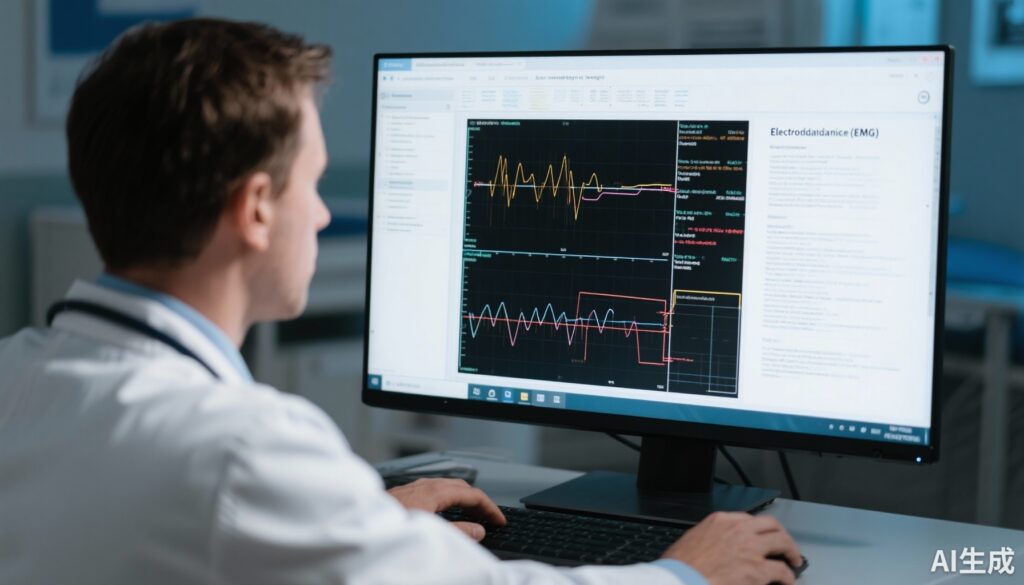Highlight
- An AI-assisted interpretation tool (INSPIRE) was tested versus physician-only EMG reporting in a randomized controlled trial involving 200 patients.
- The AI-physician integrated reports showed no significant improvement in accuracy or completeness over physician-only reports based on the novel AI-Generated EMG Report Score (AIGERS).
- Physicians reported moderate trust in AI suggestions but noted issues with usability, efficiency, and workflow disruption.
- AI assistance may still reduce documentation burden by automating routine EMG report elements, potentially allowing physicians to focus on complex cases.
Study Background and Disease Burden
Electrodiagnostic (EDX) studies, including electromyography (EMG) and nerve conduction studies, are crucial diagnostic tools for neuromuscular disorders such as neuropathies, myopathies, and motor neuron diseases. Accurate interpretation of EDX outcomes is essential for appropriate diagnosis, prognosis, and treatment planning. However, interpreting EDX data requires specialized expertise, and variability can exist among physicians due to complexity and subjective elements of analysis.
Emerging artificial intelligence (AI) technologies offer potential to standardize EDX interpretation, improve accuracy, and reduce physician workload by automating report generation. However, clinical evidence evaluating AI tools for EDX reporting remains scarce. This trial aimed to fill this gap by comparing an AI-assisted multi-agent framework, INSPIRE, with standard physician-only interpretation in a rigorous randomized controlled design.
Study Design
This prospective, single-center randomized controlled trial enrolled 200 patients referred for clinically indicated EDX studies out of 363 initially screened. Participants were randomly allocated 1:1 to either a control arm with physician-only EMG interpretation or an intervention arm with combined AI-assisted and physician interpretation.
Three board-certified neurologists trained in EDX rotated across both arms to mitigate operator bias. In the intervention arm, INSPIRE generated a preliminary AI report which was then reviewed alongside the physician’s independent interpretation to produce an integrated report. The primary efficacy endpoint was the quality of EDX reports measured by the newly designed AI-Generated EMG Report Score (AIGERS), a quantitative metric ranging from 0 to 1, with higher scores denoting greater diagnostic accuracy and completeness.
Secondary outcomes included physician-reported AI Integration Rating (PAIR) scores assessing trust, efficiency, ease of use, and workload impact, as well as a compliance survey evaluating the feasibility of AI adoption in clinical practice.
Key Findings
The trial enrolled 200 patients equally divided across the two arms. The AI-generated preliminary reports alone demonstrated moderate consistency with the AIGERS metric. However, the integrated physician plus AI reports did not statistically outperform physician-only reports regarding the primary outcome (mean AIGERS scores were similar, p > 0.05).
While the AI tool efficiently suggested standardized terminology and report structure, this effect did not translate to significant improvement in overall report quality. The lack of statistical superiority suggests AI assistance may not yet surpass expert physician interpretation alone in EMG reporting accuracy.
Physician feedback highlighted variable acceptance of AI recommendations. Trust in AI suggestions averaged 3.7 out of 5, indicating moderate confidence. Conversely, ratings for operational efficiency (2.0/5), ease of use (1.7/5), and workload reduction (1.7/5) were low. These findings signal significant usability challenges, including workflow interruption and interpretability concerns of AI outputs.
Despite these limitations, qualitative observations suggested that AI might reduce time spent on routine or straightforward EMG analyses by automating report text generation or flagging standardized terminologies, potentially freeing physicians to focus on diagnostically complex cases.
Expert Commentary
This trial contributes to the evolving evaluation of AI’s role in neuromuscular diagnostics by providing rigorous randomized data. The findings underscore that while AI tools hold promise for supporting EDX interpretation, current implementations like INSPIRE may still face hurdles in clinical integration, particularly regarding usability and physician trust.
The study’s strengths include its prospective design, randomization, multi-physician involvement, and creation of a quantitative quality scoring system (AIGERS) tailored to EDX reports. Limitations include its single-center setting and the relatively small sample size that may underpower detection of subtle benefits. Further, AI performance might improve with iterative training and incorporation of broader datasets.
Current guidelines do not yet incorporate AI-assisted EDX interpretation but acknowledge the pressing need for advanced decision support tools to alleviate specialist workload amid growing demand for neuromuscular diagnostics. Future research should explore refining AI algorithms for better interpretability, user interface improvements, and assessment across diverse clinical environments.
Conclusion
In summary, the INSPIRE AI-assisted EMG interpretation system did not significantly outperform expert physician-only reporting in this randomized controlled trial. However, AI’s potential to alleviate routine documentation effort and support physicians in complex diagnostic decision-making remains encouraging.
This study highlights the importance of balancing technological advances with workflow integration and physician acceptance. Continued development and validation of AI-driven diagnostic support are warranted to realize their promise in enhancing neuromuscular disease management.
References
Gorenshtein A, Weisblat Y, Khateb M, Kenan G, Tsirkin I, Fayn G, Geller S, Shelly S. AI-Based EMG Reporting: A Randomized Controlled Trial. J Neurol. 2025 Aug 22;272(9):586. doi: 10.1007/s00415-025-13261-3. PMID: 40844612; PMCID: PMC12373542.
Ting DSW, et al. AI for dermatology: the next frontier of innovation? Lancet Digit Health. 2020;2(12):e632-e635.
Shamseer L, et al. CONSORT 2010 explanation and elaboration: updated guidelines for reporting parallel group randomized trials. BMJ. 2010;340:c869.
Khateb et al. Artificial intelligence in neurology: promises and pitfalls. Front Neurol. 2023;14:1007001.



